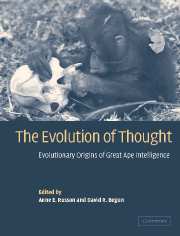Book contents
- Frontmatter
- Contents
- List of Contributors
- Preface
- 1 Evolutionary reconstructions of great ape intelligence
- 2 Enhanced cognitive capacity as a contingent fact of hominid phylogeny
- PART I COGNITION IN LIVING GREAT APES
- PART II MODERN GREAT APE ADAPTATION
- Introduction
- 7 What's in a brain? The question of a distinctive brain anatomy in great apes
- 8 Life histories and the evolution of large brain size in great apes
- 9 Evolution of complex feeding techniques in primates: is this the origin of great ape intelligence?
- 10 The special demands of great ape locomotion and posture
- 11 Great ape social systems
- 12 Diet and foraging of the great apes: ecological constraints on their social organizations and implications for their divergence
- PART III FOSSIL GREAT APE ADAPTATIONS
- Part IV INTEGRATION
- Author index
- Species index
- Subject index
9 - Evolution of complex feeding techniques in primates: is this the origin of great ape intelligence?
Published online by Cambridge University Press: 20 August 2009
- Frontmatter
- Contents
- List of Contributors
- Preface
- 1 Evolutionary reconstructions of great ape intelligence
- 2 Enhanced cognitive capacity as a contingent fact of hominid phylogeny
- PART I COGNITION IN LIVING GREAT APES
- PART II MODERN GREAT APE ADAPTATION
- Introduction
- 7 What's in a brain? The question of a distinctive brain anatomy in great apes
- 8 Life histories and the evolution of large brain size in great apes
- 9 Evolution of complex feeding techniques in primates: is this the origin of great ape intelligence?
- 10 The special demands of great ape locomotion and posture
- 11 Great ape social systems
- 12 Diet and foraging of the great apes: ecological constraints on their social organizations and implications for their divergence
- PART III FOSSIL GREAT APE ADAPTATIONS
- Part IV INTEGRATION
- Author index
- Species index
- Subject index
Summary
DOES GREAT APE INTELLIGENCE DIFFER FROM THAT OF MONKEYS?
There is growing consensus that great apes' intellectual abilities are qualitatively distinct from those of other primate taxa, as seen in their mirror self-recognition (e.g., Gallup, 1970) causal understanding of tool-using tasks without trial and error (Visalberghi, Fragaszy & Savage-Rumbaugh 1995), and imitative ability (e.g., Custance, Whiten & Bard 1995), among other traits and abilities (see Russon, Bard & Parker 1996; other chapters this volume). This raises the important question: In what ecological and social environments did this distinct intellectual capacity evolve?
Potential answers have been much discussed in recent years. Using brain parameters (e.g., absolute or relative brain size, neocortex ratio) as proxies for the rather amorphous concept of “intelligence,” comparative studies (Dunbar 1992, 1995) have found that the size of the social network (represented by group size) better explains variation in the neocortex ratio among primate taxa than any of the ecological parameters considered thus far, such as degree of frugivory, range size, or presence/absence of “extractive foraging.” This suggests that the social complexity resulting from primate-style group living is more likely to be behind variations in primate intelligence, as the so-called “social intellect hypothesis” sets out (Chance & Mead 1953; Humphrey 1976), than the ecological complexity arising from foraging problems, as some others have suggested (Menzel 1997; Milton 1981; Parker & Gibson 1979).
- Type
- Chapter
- Information
- The Evolution of ThoughtEvolutionary Origins of Great Ape Intelligence, pp. 140 - 171Publisher: Cambridge University PressPrint publication year: 2004
- 15
- Cited by



